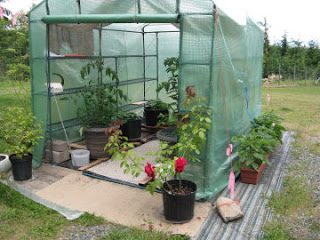 |
| Brassicas with trays for shade |
 |
| Burlap to protect from sun and heat |
When the shade trays are removed from all varieties of squash, each hill gets a stake placed as a marker for watering. When the plants get large and spread out, the stake is where the stem and roots are, so hand watering is easy. This is also done with pickling cucumbers and any other sprawling plants.
 |
| Bamboo stakes for squash |
 |
| Tomatoes, pruned and staked |
The tomatoes have been staked for support. These plants are my 'Outdoor Salsa', now being sold on Denman through Annie Siegel as 'Sally's Salsa'. For all tomatoes, I prune leaves from the bottom so none touch the soil. Also prune out all suckers, (except one) that start growing from the leaf attachment on the stem. I allow the main stem and one off shoot, both are staked separately. With this particular variety, once the fruit is pollinated, I leave only 2-3 fruit per set. My main goal with these is seed saving and keeping this variety of very large fruit with few seeds. I am hoping to break my previous record weight of 1lb. 10-1/4oz for one tomato, from two years ago!
 |
| Strawberry hoops and netting |
 |
| Desert King Figs |
I was thrilled to count 65 figs ripening on my Desert King tree. The photo shows an area of the tree where I pinched the bud tips in the spring. Each of these branches produced 4-5 figs and several new shoots for next year's fruit. I am still working on the pruning and pinching method and realize some of these new shoots are on branches that will be pruned in the fall. Obviously my experiment needs to be tweaked. The tiny branch from my April 27th post
 |
| Bud tip was pinched in April |
Well, that's the tip of the iceberg around the garden these days! We have been enjoying fresh sugar snap peas, strawberries, cucumbers and baby zucchini. It is great to have longer days, be outside and have dirt under my fingernails. The weeds have got the best of me and taken over in some areas but such is life in Paradise!
Till next time... Bon Appétit and Happy Canada Day!
Photos by Sally Rae
